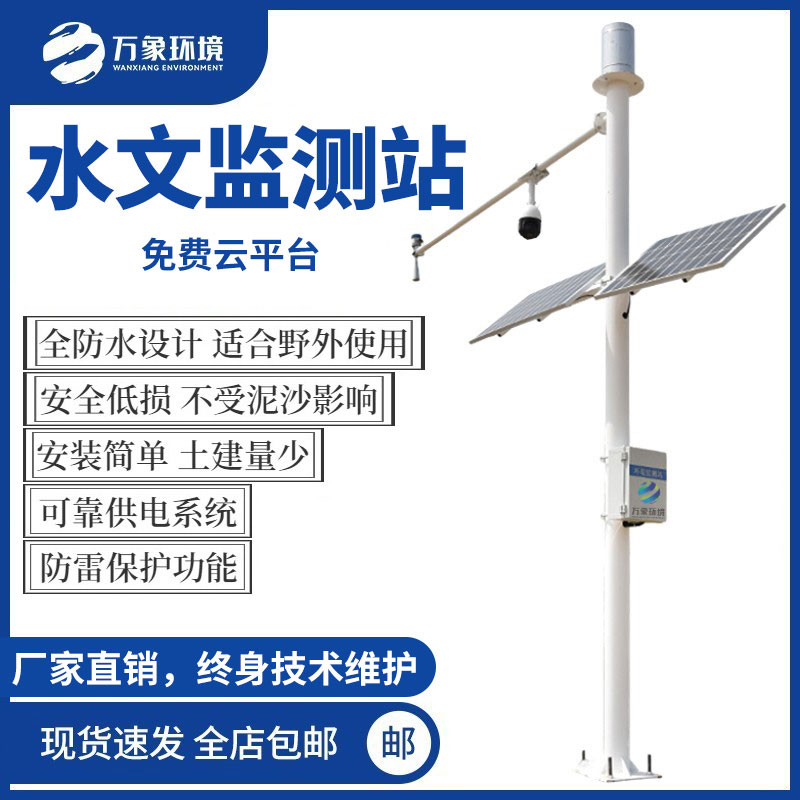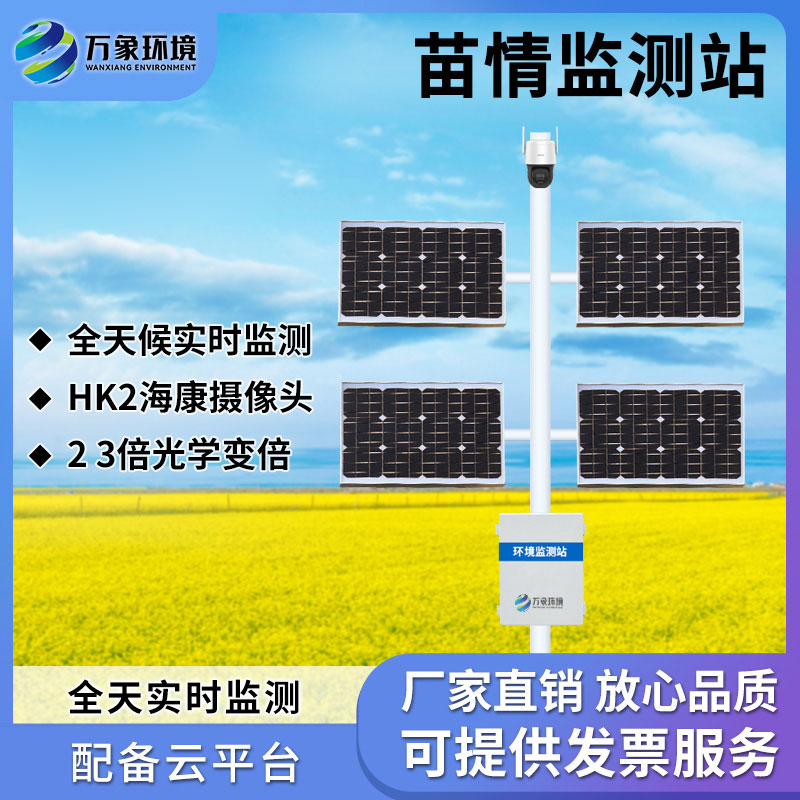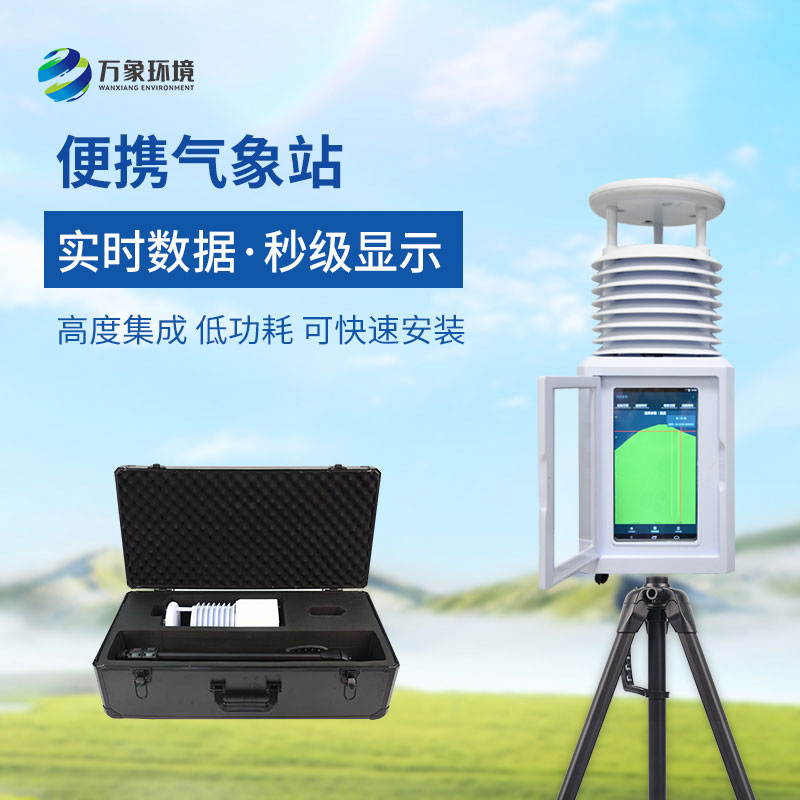Water level, flow rate and flow monitoring station Product Overview
A water level, flow rate, and flow rate monitoring station is a comprehensive hydrological monitoring facility that integrates various monitoring functions such as water level, flow rate, and flow rate. It can obtain real-time and accurate data of water bodies, providing scientific basis for the development, utilization, and management of water resources.
WX-LDSW03 is a fully automatic hydrological online monitoring system based on
microwave technology, which can simultaneously measure the water level, flow and
rainfall in the channel . It uses advanced K -band planar radar technology to
measure the water level of the water body in a non-contact manner. It can be
used for non-contact flow measurement in rivers, irrigation canals, underground
drainage networks, flood prevention and early warning, etc. The product has the
characteristics of low power consumption, small size, high reliability and easy
maintenance; the measurement process is not affected by factors such as
temperature, sediment, river pollutants, and floating objects on the water
surface.
2.Water level, flow rate and flow monitoring station Application fields
1. Water level and rainfall measurement of rivers, lakes, tides, reservoir
gates, underground water pipe networks, irrigation canals, etc.
2. Auxiliary water treatment operations, such as urban water supply, sewage
monitoring, etc.
3. Product Features
1. It is suitable for various measurement conditions, is not affected by
corrosion and foam, and can output water level measurement data.
2. The water level adopts a planar array radar antenna with built-in angle
measurement function. The equipment is small in size and easy to install.
3. Convenient configuration software can easily configure parameters
according to actual needs to adapt to different usage conditions.
4. Not affected by changes in water vapor, temperature and pressure in the
atmosphere
4. Monitoring Platform
1. CS architecture software platform, supports direct observation via mobile
phone and PC browser , no need to install additional software.
2. Support multiple accounts and multiple devices to log in
3. Support real-time data display and historical data display dashboard
4. Cloud servers and cloud data storage are stable, reliable, easy to expand,
and load balanced.
5. Support SMS alarm and threshold setting
6. Support map display and view device information.
7. Support data curve analysis
8. Support data export in table format
9. Support data forwarding, HJ-212 protocol, TCP forwarding, http protocol,
etc.
10. Support data post-processing function
11. Support external running of javascript scripts
V. Summary indicators
Supply voltage: 100mA (working), < 1mA ( sleeping ) ;
Working voltage: 12V power supply
Operating temperature: -35 ℃ ~60 ℃;
Storage temperature: -40 ℃ ~60 ℃;
Field protection level: IP68
Signal output: RS485/MODBUS protocol;
6. Technical parameters
Water level measurement
Measuring range: 0.4-40 meters
Distance measurement accuracy: ± 1cm
Distance measurement resolution: 1mm
Interval time: 1-5000min
Flow rate measurement
Measuring range: 0.15 ~ 15m/s
Speed measurement accuracy: ± 2%
Speed resolution: 0.01m/s
Rainfall monitoring
Measuring range: Rain intensity 0 ~ 4mm/min
Measuring accuracy: ± 0.2mm
Resolution: 0.2mm
Rainwater receiving diameter: φ 200mm
Power supply mode: solar panel + battery combination power supply
Bracket height: 4 meters
Working environment: -20 ℃~80 ℃ (no freezing)
7. Installation precautions
1. Installation environment
There are no huge rocks blocking the water in the test channel section, and
there are no huge whirlpools, turbulent flow, etc.
The test channel section should be straight, stable and have concentrated
water flow
The test channel section needs to be hardened and the measurement section
should be regular.
The test channel section should be kept smooth to prevent floating objects
from accumulating.
2. Installation height
Recommended installation height 3-4 meters
Attachment: Hydrological Monitoring Station Construction Manual
1. Principles of layout:
1. The land use situation within 1,000 meters of the monitoring point is
relatively stable;
2. The horizontal plane around the monitoring point should ensure a capture
space of more than 270 °. If the monitoring point is close to a building, the
horizontal plane around the monitoring point should have a free space of more
than 180 °;
3. The surrounding environment of the monitoring point is relatively stable,
the location conditions must be long-term stable and sufficiently solid, and the
safety and fire prevention measures must be guaranteed;
4. There is no strong electromagnetic interference or strong shock source
near the monitoring point, and there should be stable lightning protection
equipment around it as much as possible;
5. The monitoring point should have smooth and convenient access and
conditions to facilitate maintenance;
6. The height of the monitoring point sensor should be within 2-5 meters from
the ground;
7. There are no obvious fixed pollution sources within 50 meters around the
monitoring point ;
8. If the weather station is installed on a non-customized monitoring pole,
the load-bearing capacity of the base pole must be considered;
9. The monitoring point should be selected in a place with sufficient light
(the daytime light time should be kept for more than 6 hours ) or there should
be a stable and reliable AC220V power supply around the monitoring point .
2. Point confirmation
After the selection of the points is completed, the points will be marked on
the plane map of the monitoring area. The plane map with the location marks of
the monitoring points will be submitted to Party A for confirmation and
signature.
3. Construction
1. Pre-buried monitoring pole cage
1) According to the actual geological conditions on site, the pre-buried pit
for the monitoring pole foundation is constructed by manual labor and
excavation. The size of the pre-buried pit is 100cm (length) *100cm (width)
*100cm (depth). In case of over-excavation, the abandoned soil shall not be used
for on-site backfilling, and gravel or sand shall be used to backfill to the
design value. The edge of the pre-buried pit should be aligned with the due
south and due north directions;
2) Place the embedded parts vertically in the pit with the threads facing
upwards, and fill the pit with concrete (cement: sand = 1:3 ) until it is
slightly above the ground level;
3) Depending on the season and local climate, air-dry for about 3 days until
the cement foundation is completely solidified to complete the
pre-embedding.
2. Equipment installation and monitoring pole erection
1) Fix the equipment on the equipment bracket with matching bolts, and pay
attention to the installation of flat spring washers;
2) Use matching bolts to fix the equipment bracket about 3 meters from the
monitoring pole;
3) Install the solar panel on the solar panel bracket with matching
bolts;
4) Install the radar water level sensor on the flange with matching fasteners
and fix the flange to the bracket.
IV. Construction quality control requirements and safety precautions
1. The whole process of monitoring pole construction should be carried out in
sequence, and the pole appearance should be straight, streamlined, smooth and
vertical;
2. The solar panel is tilted 45 ° towards the south;
3. The anti-rust layer of the monitoring rod must not be damaged;
4. The cable connectors are firm and reliable, waterproof and insulated, and
not easily exposed;
5. Pay attention to the safety of pedestrians and vehicles during
hoisting;
6. When hoisting the monitoring pole, be sure to tie a rope to control the
stability of the lifting object;
7. Warning signs should be set up during lifting.
V. Construction Quality Assurance Measures
1. The main materials required should comply with the design documents and
current standard requirements, and must have a factory certificate and should be
tested when necessary.
2. Construction is strictly controlled according to the requirements of the
specifications. And process inspection is carried out. Only when the previous
process is qualified can the next process be constructed.
3. Strengthen quality awareness, strictly organize construction according to
the design, current construction specifications and rules, as well as the
owner's special requirements and on-site instructions, implement excellence work
throughout the entire construction production process, and ensure project
quality.
4. Strengthen process quality control, strictly organize production according
to the quality assurance system, formulate operation standards, process
standards, and inspection standards for each process and each link, keep records
of the implementation of process standards, ensure that each process is
connected in an orderly manner and achieve traceability.
5. Strengthen project management, implement the technical responsibility
system, formulate targeted special construction plans, and carry out technical
briefings carefully.
6. During construction, ensure that each sub-project is of high quality
standard and all are of qualified quality, and establish model projects to drive
the implementation of the entire project.
VI. Measures to ensure construction period
1. Strengthen technical guidance, strict management, and effective
organization and coordination.
2. Strengthen management, improve the internal economic responsibility
system, give play to the role of economic levers, and fully mobilize the
enthusiasm and consciousness of the construction team as the organizational and
ideological guarantee to ensure the construction period.
3. Organize a team with rich experience and strong construction capabilities;
the personnel and mechanical equipment are well-equipped and complete to ensure
that the construction plan is completed every day.
4. Grasp the node targets in stages. To facilitate inspection, assessment and
adjustment, under the control of the overall construction plan, prepare the left
and right construction plan targets, emphasize the node progress, and
effectively control the realization of the overall plan.
5. Strengthen the management of material procurement and supply, and ensure
timely supply of materials to meet the needs of project construction.
6. Actively coordinate relationships and create a good construction
environment. Organize construction according to procedures to effectively
control various factors that affect progress.
7. Safety construction management measures
During the implementation process, strictly abide by the laws and regulations
on safety, health and environmental hygiene. Safety devices, equipment and
protective equipment and other effective measures should be taken to protect the
life, health and safety of on-site construction and supervision personnel;
8. Environmental Protection Measures
1. Waste treatment : Materials that are not suitable for filling should be
neatly stacked or transported to designated places in a timely manner;
2. Construction wastewater should be discharged to the sewer in a timely
manner and should not pollute natural water sources. Noise pollution should be
prevented at the construction site and construction vehicles should not sound
their horns;
3. Prevent the excavated soil from being washed away or overflowed by
rainwater, as secondary dust is easily generated in dry weather. The transport
crossings near the excavator need to be cleaned in time.
9. Installation photos
Product address:
http://www.qxhjjc.com/en/shuiwen/1097.html 

















 Home
Home phone
phone Product Overview
Product Overview Contact Us
Contact Us